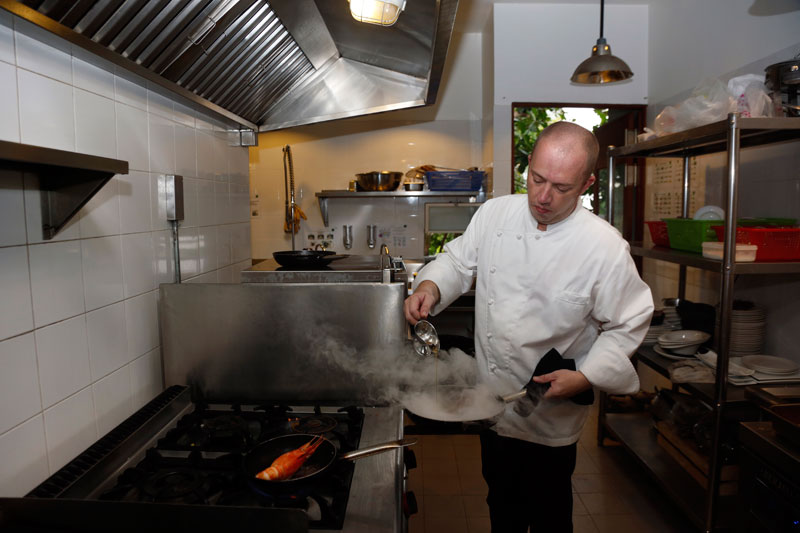Chef Sebastien Rubis of The Plantation hotel in Phnom Penh holds the philosophy that no matter how many elements there are on a plate, there should be a common thread running through them.
For example, a dish he named “Meat of the Sea,” which will be on the hotel restaurant’s menu next month, consists of a beef filet, a king prawn and a large scallop.

“You have three elements on the plate combining five flavors,” he said. “If each one was done on its own, it would feel like disorder when eating; one’s palate would be confused, wondering what this is.
“So there has to be a common thread. For this dish, I do this by flambeing each component with cognac…. With other dishes, I may use a bulb like shallots or pepper.”
The dish starts with beef marrow that is prepared for the sauce and five small carrots, which are caramelized and painstakingly cut into five-sided pieces.
Then, after marinating the scallop in olive oil, the fillet, prawn and scallop are quickly cooked in three separate pans before being deglazed with white wine and flambeed.
Once assembled, the dish consists of the prawn—with its head left on—placed next to the large scallop on the steak. The dish is topped with a parmesan tuile.
Mr. Rubis, who grew up in a suburb of Paris, studied at the Ecole de Paris des Metiers de la Table, du Tourisme et de l’Hotellerie—Paris’ school of cooking and pastry trades, tourism and hospitality.
During his mandatory military service at the age of 21, he found himself in the kitchen of the Hotel de Brienne, the official residence of the French defense minister. There, he worked under a sous chef for Paul Bocuse, one of the pioneers of Nouvelle Cuisine.
After working for several restaurants in Europe, Mr. Rubis relocated to Southeast Asia in late 2002, working at a restaurant in Chiang Mai and then in Luang Prabang. He later joined a hotel group where he was tasked to set up restaurant operations at new hotels in Thailand and Laos. He joined The Plantation in September 2014.
One of his projects at The Plantation consists of researching Khmer food with the hotel’s Cambodian chef, Khem Chong, in order to put truly traditional dishes on the menu.
While he believes in traditional cuisine, Mr. Rubis said he always looks for the “wow factor”—conceiving of a dish that will puzzle or surprise people. This can mean using a chicken bouillon base for a cauliflower soup to create a complex flavor, or offering a tomato “mille-feuille” in which the multiple layers usually found in traditional pastries consist of thin layers of mozzarella cheese crisped on a griddle and placed between slices of tomatoes with a pesto coulis.
“Today’s trend is to go back to traditional dishes—but for our time,” Mr. Rubis said.